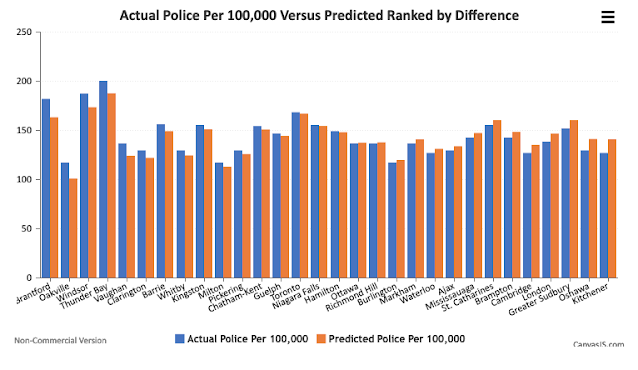Statistics Canada has released the police-reported crime statistics in Canada for 2022 and police-reported crime in Canada, as measured by the Crime Severity Index (CSI), increased for the second consecutive year, up 4% in 2022. The CSI considers both the volume and the severity of crime. The police-reported national crime rate—a measure of the volume of crime—increased by 5% from 2021 to 2022, up to 5,668 incidents per 100,000 population. However, like the CSI, the crime rate in 2022 (-4%) was lower than in 2019.
Figures 1 and 2 provide the 2022 CSI and Crime Rate Per
100,000 population for Canada 35 CMAs and ranks them from highest to
lowest. Crime Severity was highest in
Winnipeg, followed by Kelowna and Lethbridge while in terms of crime rates,
Kelowna topped the ranking followed by Lethbridge and then Winnipeg. In terms of crime severity, Thunder Bay ranked
7th highest of the 35 CMAs whereas in terms of crime incidents per
100,000, Thunder Bay dropped to 10th spot. For those interested in a northern Ontario comparison, Thunder Bay's crime severity and crime rate exceeds Greater Sudbury.
In the case of Thunder Bay, to provide some additional time series perspective, Figure 3 plots both crime severity and the number of police officers per 100,000 population from 2000 to 2022. Crime Severity has fluctuated somewhat over time though it has been on an upward trend since 2015 but remains below the peak year of 2009 when it reached nearly 115. Between 2015 and 2022, Crime Severity in Thunder Bay grew by 27 percent but if one looks at the period 2000 to 2022, then there has been a decline in crime severity of just over two percent.
Another metric – not shown in any charts here – is the crime rate and the total number of crime incidents. In 2000, the total number of total crime violations in Thunder Bay was 10,869 whereas by 2021 it had fallen to 8,117 – a decline of about 25 percent. Over the same period, the number of total crimes per 100,000 fell from 9084 to 6940 – a drop of 24 percent. If one takes the 2022 numbers in consideration, the rate appears to have declined further to 5842.
It is always interesting to compare the crime time series numbers to police resource numbers. Policing numbers per 100,000 have trended upward throughout the period going from 173 officers per 100,000 population in 2000 and reaching 213 in 2022. This represents an increase in per capita policing resources of 23 percent. It should be noted that over the same period, the total number of civilian employees grew from 95 to 119 while the total number of officers grew from 207 to 249 – total increases of 25 and 20 percent respectively.
Putting these increases into perspective, it helps to have
some population numbers. Over the same
period, the population of Thunder Bay, Municipal as reported in these crime
statistics by Statistics Canada fell from 119,657 to 116,968 – a decline of 2.2
percent. This is certainly a different number than one has seen in the past
referring to either the CMA or the municipal population. While this is a larger
number than the 2021 census city of Thunder Bay population figure of 108,843,
it is also smaller than the CMA census population of 123,258. One city, many population statistics.
So, that is a brief overview of the numbers. Make of them what you wish. One imagines that personal and individual experience with crime never mind population growth in Thunder Bay may vary depending on your location or socioeconomic status.



























